Readings Newsletter
Become a Readings Member to make your shopping experience even easier.
Sign in or sign up for free!
You’re not far away from qualifying for FREE standard shipping within Australia
You’ve qualified for FREE standard shipping within Australia
The cart is loading…






This title is printed to order. This book may have been self-published. If so, we cannot guarantee the quality of the content. In the main most books will have gone through the editing process however some may not. We therefore suggest that you be aware of this before ordering this book. If in doubt check either the author or publisher’s details as we are unable to accept any returns unless they are faulty. Please contact us if you have any questions.
Discovered in the seventies, Black-Scholes formula continues to play a central role in Mathematical Finance. We recall this formula. Let (B ,t? 0; F ,t? 0, P) - t t note a standard Brownian motion with B = 0, (F ,t? 0) being its natural ?ltra- 0 t t tion. Let E := exp B? ,t? 0 denote the exponential martingale associated t t 2 to (B ,t? 0). This martingale, also called geometric Brownian motion, is a model t to describe the evolution of prices of a risky asset. Let, for every K? 0: + ? (t) :=E (K?E ) (0.1) K t and + C (t) :=E (E?K) (0.2) K t denote respectively the price of a European put, resp. of a European call, associated with this martingale. Let N be the cumulative distribution function of a reduced Gaussian variable: x 2 y 1 ? 2 ? N (x) := e dy. (0.3) 2? ?? The celebrated Black-Scholes formula gives an explicit expression of? (t) and K C (t) in terms ofN : K ? ? log(K) t log(K) t ? (t)= KN ? + ?N ? ? (0.4) K t 2 t 2 and ? ?
$9.00 standard shipping within Australia
FREE standard shipping within Australia for orders over $100.00
Express & International shipping calculated at checkout
This title is printed to order. This book may have been self-published. If so, we cannot guarantee the quality of the content. In the main most books will have gone through the editing process however some may not. We therefore suggest that you be aware of this before ordering this book. If in doubt check either the author or publisher’s details as we are unable to accept any returns unless they are faulty. Please contact us if you have any questions.
Discovered in the seventies, Black-Scholes formula continues to play a central role in Mathematical Finance. We recall this formula. Let (B ,t? 0; F ,t? 0, P) - t t note a standard Brownian motion with B = 0, (F ,t? 0) being its natural ?ltra- 0 t t tion. Let E := exp B? ,t? 0 denote the exponential martingale associated t t 2 to (B ,t? 0). This martingale, also called geometric Brownian motion, is a model t to describe the evolution of prices of a risky asset. Let, for every K? 0: + ? (t) :=E (K?E ) (0.1) K t and + C (t) :=E (E?K) (0.2) K t denote respectively the price of a European put, resp. of a European call, associated with this martingale. Let N be the cumulative distribution function of a reduced Gaussian variable: x 2 y 1 ? 2 ? N (x) := e dy. (0.3) 2? ?? The celebrated Black-Scholes formula gives an explicit expression of? (t) and K C (t) in terms ofN : K ? ? log(K) t log(K) t ? (t)= KN ? + ?N ? ? (0.4) K t 2 t 2 and ? ?